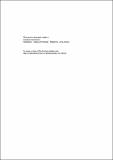| dc.contributor.author | Haugerud, Angelique | |
| dc.date.accessioned | 2011-11-17T13:15:02Z | |
| dc.date.available | 2011-11-17T13:15:02Z | |
| dc.date.issued | 1981-07 | |
| dc.identifier.citation | Haugerud, Angelique (1981) Development and household economy in two eco-zones of Embu district. Working paper no. 382, Nairobi: Institute for Development Studies, University of Nairobi | en_GB |
| dc.identifier.uri | https://opendocs.ids.ac.uk/opendocs/handle/20.500.12413/1252 | |
| dc.description.abstract | This paper addresses the relationship between household economy and processes of development in two eco-zones of Embu District. It examines three principal types of rural household economic investment: l) land purchases; 2) small business; and 3) agricultural production. Patterns of household investment suggest that rural economic growth may be propelled largely by off-farm income and investment, though the success of such non-agricultural investment depends heavily on the health of small-scale agriculture.
Most types of agricultural investment examined tend to be concentrated among large land owners and households with regular off-farm income. However, while those with substantial off-farm income and larger than average farms are both more able and likely to invest in agriculture than are other smallholders, the former tend to invest more in land purchases and business itself than in agricultural production. Many land purchases are not made strictly for agricultural purposes but for possible future resale (due to rapidly rising prices) or as a form of security for obtaining loans for non-agricultural investment.
In short, there are two distinct sets of small-scale agricultural producers with quite different needs and investment capacities.
The first (possibly 25-35 percent of Embu smallholders) is the larger land owners with substantial off-farm income and a tendency to invest somewhat in agricultural production but more so in other areas such as land purchases and small businesses. The second set (65 to 75 percent of Embu smallholders) has less, land, less off-farm income, and a high propensity to invest nearly all of its resources in secondary education. Field data indicates an improvement on the living standard of the wealthiest 25 to 35 percent of the population. A variety of factors, however, limit economic advance and improved welfare among the 5 to 75 percent majority of smallholders. | en_GB |
| dc.language.iso | en | en_GB |
| dc.publisher | Institute for Development Studies, University of Nairobi | en_GB |
| dc.relation.ispartofseries | Working Papers.;382 | |
| dc.rights.uri | http://creativecommons.org/licenses/by-nc-nd/3.0/ | en_GB |
| dc.subject | Agriculture | en_GB |
| dc.subject | Economic Development | en_GB |
| dc.title | Development and household economy in two eco-zones of Embu district | en_GB |
| dc.type | Series paper (non-IDS) | en_GB |
| dc.rights.holder | Institute for Development Studies, University of Nairobi | en_GB |
| dc.identifier.blds | 324854 | |


